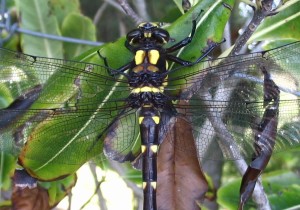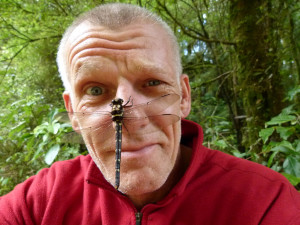I’m subscribed to a number of YouTube sites, and BBC Earth is one of them, but as usual Amy Carparelli was quicker off the mark than me and brought this one to my attention before I got around to checking my subscriptions.
This one describes the amazing vision of the dragonfly.
New Zealand has some native dragonflies. I don’t know how many, but the largest is the Kapokapowai (uropetala carovei), which means water snatcher. Wai (why) = water; kapo (car-poe) = snatch. The double “kapo” emphasizes the action to denote snatcher.
According to Wikipedia:
Uropetala carovei, or New Zealand bush giant dragonfly … is a giant dragonfly of the family Petaluridae, endemic to New Zealand. The Māori name means “water snatcher” alluding to the water dwelling larva, which, like all dragonflies, has a long extendable jaw that shoots out to snatch prey.
The yellow and black body can be up to 86 mm long, with a wingspan up to 130 mm, making it the largest dragonfly in New Zealand. Males have petal-shaped hind appendages. Its diet is smaller insects, including cicadas. They are preyed on in turn by rats, kingfishers and even wasps.
They are slow and noisy fliers.
The nymphs tunnel into the soft earth of a stream bank or seepage, where they occupy a chamber half-filled with water for about five years. They emerge at night to seek prey near the burrow entrance. They are sensitive to disturbance so are rarely observed.



Dragonflies, ancient species that have survived at least 3 extinction events. They have changed some but still have the same basic body type.
I was fascinated by their morphology, their huge eyes and their double wing configurations that allow them to hover and even fly backwards. Not too many fliers can do that. They can catch and trap bees in their six legs and eat them alive while still flying. Their aquatic early stages are so different even to an alienesque under claw that snaps out from under the head, grabs and pulls prey in even to small fishes to sup upon. Dazzling evolution. They figure in my writings of fiction in several ways from adapted technology to biotechnology to fanciful mutations of.
That’s amazing! The more I hear about them, the more interesting they become. Evolution is cool!
Wooo! Amazing stuff. I subscribed to that BBC channel.
It’s well worth it. They have very cool stuff all the time! 🙂
Well, that settles it; I can’t invite a dragonfly to watch the new Star Wars movie.